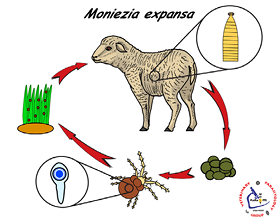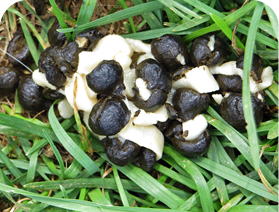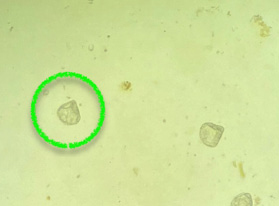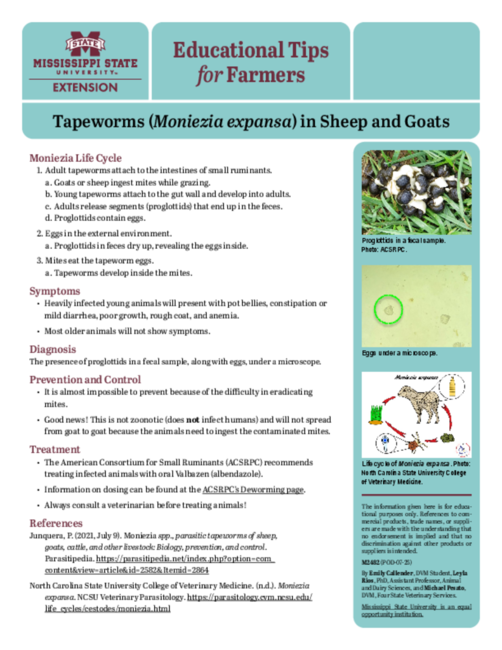M2482
Educational Tips for Farmers: Tapeworms (Moniezia expansa) in Sheep and Goats
Moniezia Life Cycle
- Adult tapeworms attach to the intestines of small ruminants.
- Goats or sheep ingest mites while grazing.
- Young tapeworms attach to the gut wall and develop into adults.
- Adults release segments (proglottids) that end up in the feces.
- Proglottids contain eggs.
- Eggs in the external environment.
- Proglottids in feces dry up, revealing the eggs inside.
- Mites eat the tapeworm eggs.
- Tapeworms develop inside the mites.

Symptoms
- Heavily infected young animals will present with pot bellies, constipation or mild diarrhea, poor growth, rough coat, and anemia.
- Most older animals will not show symptoms.
Diagnosis
The presence of proglottids in a fecal sample, along with eggs, under a microscope.


Prevention and Control
- It is almost impossible to prevent because of the difficulty in eradicating mites.
- Good news! This is not zoonotic (does not infect humans) and will not spread from goat to goat because the animals need to ingest the contaminated mites.
Treatment
- The American Consortium for Small Ruminants (ACSRPC) recommends treating infected animals with oral Valbazen (albendazole).
- Information on dosing can be found at the ACSRPC’s Deworming page.
- Always consult a veterinarian before treating animals!
References
Junquera, P. (2021, July 9). Moniezia spp., parasitic tapeworms of sheep, goats, cattle, and other livestock: Biology, prevention, and control. Parasitipedia.
North Carolina State University College of Veterinary Medicine. (n.d.). Moniezia expansa. NCSU Veterinary Parasitology.
The information given here is for educational purposes only. References to commercial products, trade names, or suppliers are made with the understanding that no endorsement is implied and that no discrimination against other products or suppliers is intended.
M2482 (POD-07-25)
By Emily Callender, DVM Student, Leyla Rios, PhD, Assistant Professor, Animal and Dairy Sciences, and Michael Pesato, DVM, Four State Veterinary Services.
The Mississippi State University Extension Service is working to ensure all web content is accessible to all users. If you need assistance accessing any of our content, please email the webteam or call 662-325-2262.
